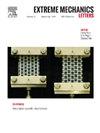Modeling the dynamics of sub-millisecond electroadhesive engagement and release times
IF 4.5
3区 工程技术
Q2 MATERIALS SCIENCE, MULTIDISCIPLINARY
引用次数: 0
Abstract
Electroadhesive clutches are electrically controllable switchable adhesives commonly used in soft robots and haptic user interfaces. They can form strong bonds to a wide variety of surfaces at low power consumption. However, electroadhesive clutches in the literature engage to and release from substrates several orders of magnitude slower than a traditional electrostatic model would predict. Large release times, in particular, can limit electroadhesion’s usefulness in high-bandwidth applications. We develop a novel electromechanical model for electroadhesion, factoring in polarization dynamics, the drive circuitry’s rise and fall times, and contact mechanics between the dielectric and substrate. We show in simulation and experimentally how different design parameters affect the engagement and release times of centimeter-scale electroadhesive clutches to metallic substrates, and we find that the model accurately captures the magnitude and trends of our experimental results. In particular, we find that higher drive frequencies, narrower substrate aspect ratios, and faster drive circuitry output stages enable significantly faster release times. The fastest clutches have engagement times less than s and release times less than s, which are 10 and 17.1 faster, respectively, than the best times found in prior literature on centimeter-scale electroadhesive clutches.
亚毫秒级电粘合剂接合和释放时间的动力学建模
电胶离合器是一种可电控的可切换粘合剂,通常用于软机器人和触觉用户界面。它们可以在低功耗下与各种各样的表面形成牢固的键合。然而,文献中的电粘合离合器与基材的接合和释放速度比传统静电模型预测的要慢几个数量级。特别是大的释放时间会限制电粘附在高带宽应用中的实用性。我们开发了一种新的电粘附的机电模型,考虑了极化动力学、驱动电路的上升和下降时间以及介电介质和衬底之间的接触力学。我们在模拟和实验中展示了不同的设计参数如何影响厘米级电粘合离合器与金属基板的接合和释放时间,我们发现该模型准确地捕捉了我们的实验结果的幅度和趋势。特别是,我们发现更高的驱动频率,更窄的衬底宽高比和更快的驱动电路输出级可以显著加快释放时间。最快的离合器啮合时间小于15μs,释放时间小于875μs,分别比现有文献中厘米级电粘合离合器的最佳啮合时间快10倍和17.1倍。
本文章由计算机程序翻译,如有差异,请以英文原文为准。
求助全文
约1分钟内获得全文
求助全文
来源期刊

Extreme Mechanics Letters
Engineering-Mechanics of Materials
CiteScore
9.20
自引率
4.30%
发文量
179
审稿时长
45 days
期刊介绍:
Extreme Mechanics Letters (EML) enables rapid communication of research that highlights the role of mechanics in multi-disciplinary areas across materials science, physics, chemistry, biology, medicine and engineering. Emphasis is on the impact, depth and originality of new concepts, methods and observations at the forefront of applied sciences.
 求助内容:
求助内容: 应助结果提醒方式:
应助结果提醒方式:


